Aaron Katz and Martha Stephens were both directing their own features before they decided to collaborate on an Iceland-set indie comedy about two older guys traveling the countryside and reconnecting with their "joie de vivre," if you will. LAND HO! played Sundance this year, where it was picked up by Sony Pictures Classics, who are currently running it in select theaters across the country (click here for the full list).
The film has been framed as a buddy comedy of sorts, but it is smarter and more delicate than you may expect. The two leads, Mitch and Colin, are somewhat archetypal, but they feel like real guys. It helps from the outset that they're both relative unknowns, and after an extended opening scene familiarizing us with their rapport, the rest of the film functions as a sort of travelogue with these aging gents as our guides. I really enjoyed it, and even though it's a small film, it plays with audiences in such a way that it's still worth seeing in theaters.
I talked with the two filmmakers about the formation of their premise, their influences, and the benefits of both careful preparation and brazen improvisation.
Just a warning: I get pretty specific with Aaron and Martha in regards to certain scenes, so some of it may be spoiler-ish or just plain perplexing if you haven't seen the film. There are no "Bruce Willis is a ghost" level spoilers or anything, but stay away if you want to go in completely fresh.
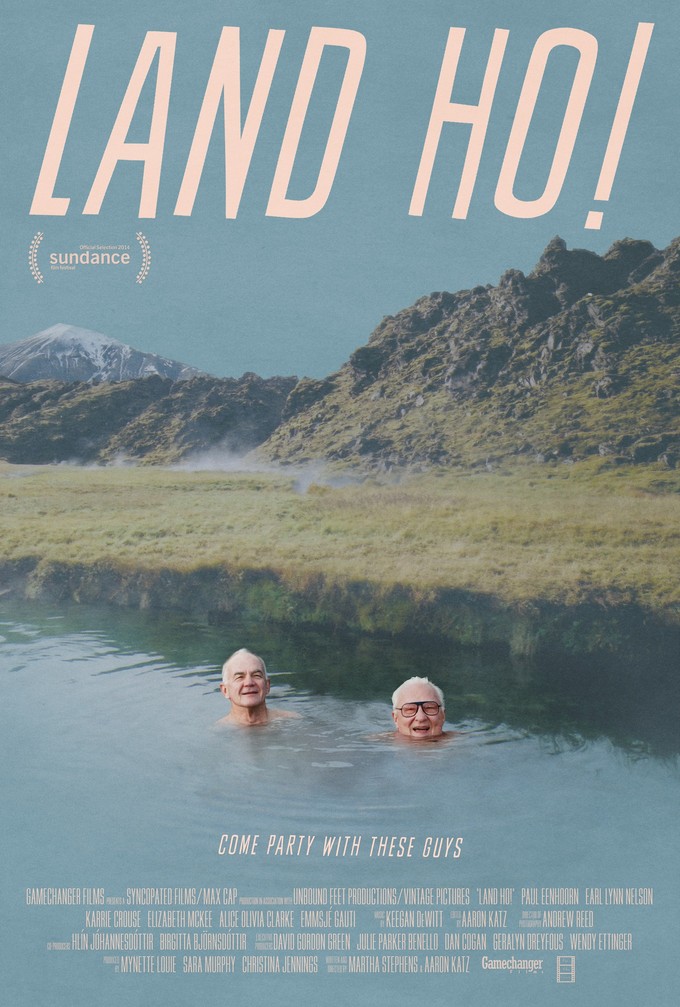
VINYARD: You guys each directed a few films on your own before, and I think this is your first collaboration. How did you guys meet, and what was it like working with a co-director?
AARON: Well, we both went to North Carolina School of the Arts in Winston-Salem, NC, which is also where our director of photography, Andy Reed, and several other of our crew members went. We've known each other for a really long time, and yeah, this is our first collaboration as directors. It just made sense. In January of last year, Martha called me with this idea which was basically like, "Let's take Earl (Lynn Nelson) to Iceland." She said that it seemed like something that would be a good collaboration, and also because it was a comedy, something neither of us had done before, might be something that we could both…I don't know, us coming together kind of results in an adventurous kind of approach to it, and I thought that was a great idea. Around the same time, we saw a film called THIS IS MARTIN BONNER, which another friend of ours from North Carolina made, and it had Paul (Eenhoorn), who plays Colin. He seemed like a perfect balance to Earl Lynn.
VINYARD: So, Martha, you came up with the project on a trip to Iceland, is that correct?
MARTHA: It was before I went on the trip. I was planning my trip, and that's sort of what sparked the idea to make a movie in Iceland. I'd always been obsessed with the sort of mystical qualities that Iceland embraces, and I wanted to go. So finally for Christmas, that was my present, this trip to Iceland. I'm looking at photos of locations that I was planning on visiting, and I just fell deeply in love with them. I love a pretty place, and It wasn't, "I want to make a movie here," it was like, "I need to make a movie here!" And I kind of wanted to make an indie movie about Iceland before anyone else had made an indie movie about Iceland.
And I also just knew Earl Lynn needed to be a leading man at some point.
VINYARD: Earl Lynn's a relative of yours?
MARTHA: He is, he's my first cousin once removed.
AARON: Like the girl in the movie.
VINYARD: Right. Can you explain a little bit about those characters, his niece and her friend? Were they based on you or anyone you knew? How did they enter into the script?
AARON: Karrie is basically playing Martha, and the Jewish mysticism expert is my wife, Elizabeth. We wrote with them in mind too, just as we wrote with the guys in mind. We wanted to have some kind of balance to the guys, and some kind of audience for them that both kind of encouraged them, but also put what they were doing and what they were talking about in a different context. Having these two women, women who are very smart and educated hanging out with these guys seemed like the right way to go.
MARTHA: Yeah, just people that the audience can relate with. Even though there is a lot of that from Colin's character too.
VINYARD: He's a lot more reserved though, he's not very expressive, but we see it right on the girls' faces. They're our "in" for the story. What about the other people in the movie? They come across a few characters, the couple at the hotel, the woman at the end at the pond, how did you conceive and cast those roles?
MARTHA: We knew the couple at the hotel. Christina Jennings, our producer, was the girl, and Ben Kasulke, who was our second camera operator, was the guy. We begged them to be in the movie.
AARON: Hoisted it on them like two days before.
MARTHA: Yeah, basically. We just really wanted a scene to show how lonely Mitch was without Colin, when he's off by himself. He's so lonely and so needy that he's okay with approaching strangers and treating them like lifelong friends. We thought there would be some comedy that could come from that scene, and I think it is a funny scene.
When Aaron and I were writing this movie, I think at some point, I was like, "Aaron, i think that the audience will want some sort of romantic moment. That's how we decided that one of them would meet a woman towards the end.
AARON: We knew we wanted that character to be someone else who was non-icelandic, someone else who was visiting the country.
MARTHA: 'Cause they were in a place where people visit, as opposed to…I guess Icelandic people go there too, but...
AARON: We really liked the idea that they really meet so few Icelanders. Really only the one, the guy with the glowsticks. I think it's very reflective of how when you go on a trip to another country, you tend to gravitate towards tourist spots and gravitate towards talking to people who are having the similar experience of being a tourist. We wrote her as Scottish, but we were open to the idea of anyone not Icelandic. Our Icelandic co-producers knew this woman, Alice Olivia, who plays Nadine, and we just met up with her.
MARTHA: She's a Canadian living in Iceland.
AARON: And she lived there for like 20 years or something. We just had coffee with her one time, then drinks with her another time, and that was it. We knew that she would be perfect for it.
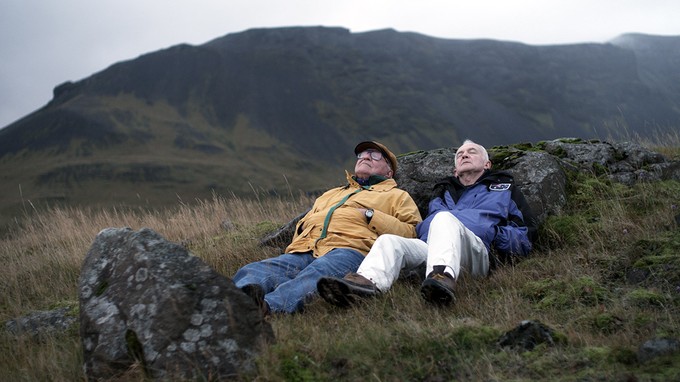
VINYARD: You said before that you wanted to take on like a buddy comedy sort of vibe. Can you talk about a few of the buddy comedies you had in mind when you were writing the script? I knew you mentioned MIDNIGHT RUN at the LAFF screening, but what were some buddy movies that were your template for this script?
MARTHA: I think when we first started writing it, obviously THE TRIP was influential, then as we went along and did more drafts, it started taking more of a turn for being more of a broad, studio comedy in some ways. You know, the joke that they're in bed together, and like a fart, the montage of them dancing, more like PLANES, TRAINS, AND AUTOMOBILES.
AARON: As the shoot went on, we kept shooting stuff that's a little more broadly comedic than we were expecting. We kept saying, "I think we're making TOMMY BOY!" Which I think was a fun spirit. It kind of had this adventurous spirit to it, and the spirit of like, "Well, if we're making TOMMY BOY, then so be it. Let's have what we call 'the spooky sequence,'" where Earl Lynn wakes Paul up.
MARTHA: Shot with like a shitty '80s horror film.
AARON: In general, we kind of threw caution to the wind, and I think part of that was going through this process of being inspired by different movies, increasingly perhaps broader, silly buddy movies, but still rooting it with very real characters.
VINYARD: You guys get some gorgeous location shots throughout the whole movie, so I'm wondering if Andrew Reed, your cinematographer, how close was he with you guys on set when you guys were improvising and stuff like that, adding shots. What was his part in that process? Because the shots are all beautiful, and they seem really well-composed, not like something you just came up with on the site.
MARTHA: We didn't really. Everything was pretty planned, honestly.
AARON: Martha and I visited all the locations for location scouts, and then Reed got there a week, maybe a little bit more, before we started shooting. We went to every location, and Reed had an iPhone app that we used essentially as a viewfinder with different lenses and everything.
MARTHA: We picked our lenses, we picked our shots. We didn't get to visit every location, but for the most part, we knew what we were doing going in. Everyday we had a shot list, and occasionally had too cross something out 'cause there wasn't enough time. The most improvised scene in terms of shooting was the Blue Lagoon scene, the last scene of the movie, the slow-motion scene. The Blue Lagoon has a clinic next door, and we thought we were shooting there at first instead of the actual Blue Lagoon for some of the shots. That's the only scene I can think of where we had to just throw away our shot list and improvise. Reed's amazing. He has these great instincts and these great ideas, so between the three of us, we came up with that sequence.
AARON: Yeah, that was a real emergency, 'cause when we showed up, things were different than we were expecting based on the scout. Like Martha said, we drew the whole thing out and told everyone, "Okay, we just need to take 20 minutes." Then Reed and Martha and I just went and filled the cracks in it.
MARTHA: We knew the vibe we wanted, we knew we wanted it to be somewhat grounded in reality, but also have a little bit of a dreaminess, a dream sequence vibe. Also, we kept saying, "We need a BAD BOYS 2 shot," or whatever.
AARON: Yeah, Michael Bay, big inspiration.
MARTHA: I would say Michael Bay was an inspiration. I mean, maybe not TRANSFORMERS Michael Bay, but…
VINYARD: BAD BOYS.
MARTHA: BAD BOYS Michael Bay, and maybe PAIN & GAIN.
AARON: (laughs) I don't know about PAIN & GAIN.
VINYARD: PAIN & GAIN, 30 years later.
MARTHA: Yeah, exactly.
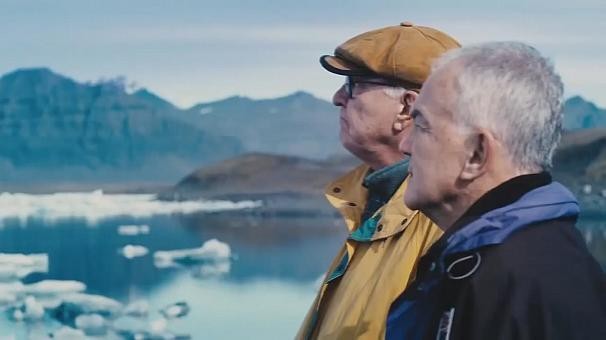
VINYARD: You said the initial idea was just to put Earl Lynn in Iceland. How close to Mitch and Colin are Earl Lynn and Paul themselves? I know very little of the script was improvised, and you wrote it for them, so how much did you base the characters on their personalities?
MARTHA: I mean, Earl Lynn is basically playing himself.
AARON: If he were here and you asked him that question, he would say, "It's all me, baby!" Paul is a professional actor, and he has some aspects of Colin that are part of his personality, but also he can cut loose. When we were in Reykjavik, he wanted to go out, he wasn't being a stick in the mud. In terms of their characters, they feel very balanced, and Paul's very good at doing that sort of even-keeled character.
VINYARD: You get a sense of him dialing it back, and just letting Mitch run with it, which is great and it's to the film's benefit.
MARTHA: But then at the end, there's the role reversal. He gets a chance to be the funny guy, and engage with this woman, and do bad impersonations, and giggle. They both switch a little bit there towards the end.
VINYARD: Was that HIGH SPIRITS reference in the script? 'Cause I remember sitting in the theater and being like, "Wait are they talking about HIGH SPIRITS?" And then, sure enough, that's the movie.
MARTHA: Yeah, that was in the script. That was a childhood favorite of mine.
VINYARD: Okay, okay.
AARON: Basically, Martha gave me TWINS if she could have HIGH SPIRITS.
VINYARD: And (Paul) was allowed to do his Arnold impression.
MARTHA: DEAD ZONE was in there too, but we cut that out. We decided it would get too weird.
VINYARD: When did David Gordon Green get involved? I saw his name listed as an executive producer.
MARTHA: David got involved because he went to the North Carolina School of the Arts. I think he has a special spot in his heart for Earl Lynn because he had seen Earl Lynn in my other movies and just thought he was really fun. David also really likes working with non-actors, so he put Earl Lynn in an episode of EASTBOUND AND DOWN for a little tiny role. I think he wanted to do anything he could to help us get this movie made, whether it was lending his name or talking to press occasionally on behalf of the movie. He watched the cut and gave his approval on things, you know.
VINYARD: How did you guys arrange financing for the film?
MARTHA: Gamechanger financed more than half of the movie, then a couple of other investors.
VINYARD: Did you come with them with footage that you shot on your scout, or was it just the script?
MARTHA: We came to them with the stuff we shot in Kentucky.
VINYARD: So you shot that first, okay.
AARON: We shot that in May of last year. The idea was to, first of all, see how Martha and I worked together as directors, because we never co-directed before. Also to see what the guys' chemistry was like, because they'd never met each other before. And then finally, to have something to show to people that it was gonna be a good idea. Mynette was already involved with the project at that point. She was able to show that to everyone else at Gamechanger, and they really showed a lot of courage in trusting us to make the movie we wanted to make. They saw that, and they said, "Okay, we like what you guys are doing, so go give us more of that."
VINYARD: (The intro) works kind of like that, it serves as a little pilot for the rest of the movie because you get a sense of their chemistry, the premise is laid out, and there's enough forward momentum that you go, "Yeah, I would like to watch these guys for another hour-and-a-half. I want to watch them do this. I want to watch them go to Iceland." It's kind of cool that it was a short film on its own, separate from the rest of the production.
AARON: I think the time difference was helpful too. Even though in the movie it probably reads like it's the next day that there in Iceland, I actually feel like having that slight 3 month difference between when we shot it gives a different feel to that scene, which makes the Iceland part feel that much more removed from their everyday life.
Also, I should mention that within the movie it's about 5-and-a-half or six minutes, but when we were showing it to investors, there were a couple more scenes of that. There was like a 12-minute version of that sequence.
MARTHA: There was like five of us, and we selected the cameras that we had, SLR cameras because we couldn't afford Reds at the time. Small operation.
AARON: There's a cabin owned by someone in Martha's family, and so when we were trying to brainstorm how to get (Mitch and Colin) together and test us, it turned out to be a really perfect way to do it. Basically by the time the weekend was over, we knew we really had something here.
VINYARD: That's a beautiful cabin, by the way.
MARTHA: Yeah, it's pretty cool. It's like untouched by time.
VINYARD: It shoots really well, 'cause the second floor has the whole side...
MARTHA: The whole glass front, yeah.
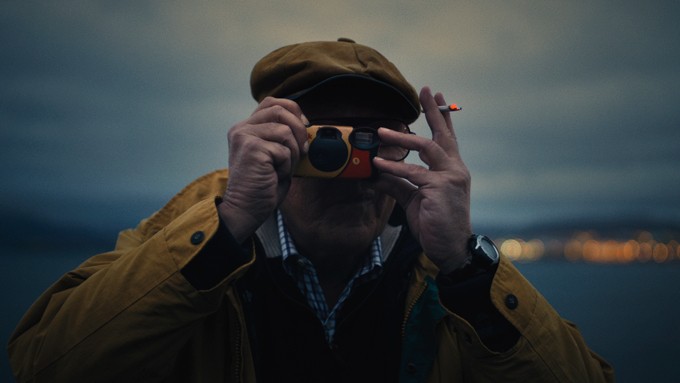
VINYARD: The music by Keegan DeWitt is obviously very deliberate. It has a very unique conversation with the events that are going on onscreen. It was clearly a choice on your guys' part to make it upbeat and poppy, and then you used Big Country towards the end. Can you talk about your approach to the music of this film? 'Cause it's a huge signature of the style and the spirit of the film.
AARON: We just wanted to have fun. I think there are a lot of different approaches you could take with the score for the film. You could take kind of the thoughtful, majestic approach, but we really wanted to highlight the fun and the spirit in which we made the rest of the film.Keegan showed up about halfway thorough the editing process. We were cutting in Los Angeles in my apartment- Martha didn't even go home to West Virginia between going to Iceland and cutting the movie. After about a week-and-a-half, Keegan showed up, plopped down on the other half of my dining room table, and we were working on cutting the film while he was working on scoring it, just kind of playing off each other. Martha and I kept pushing Keegan to go further and further ini kind of a synth-pop, world music direction somewhat inspired by Paul Simon and scores of the era. Like many other things in the movie, our initial impulse was to push it really far and then dial it back wherever we needed to, and I think that was great because we arrived at some cool places that I think, if we'd been more conservative in our approach, we never would have gotten there.
For example, the LAND HO! theme song was something that evolved after several different interations, and I think that was something we wouldn't have arrived at if we were a bit more careful. Someone asked us earlier what we learned from the making of the movie, and I think that it's not to be careful, to know your parameters and know what you're doing. That goes for any part of the movie, but in this case the score. To know what the parameters are, but within that, to explore as far as you possibly can, and to be as adventurous as you possibly can.
VINYARD: Trust the elements, obviously. Trust the environment.
AARON: Right, trust that you're working in an environment where everyone is free. That matter how crazy a suggestion or idea seems, we're all starting from the same place, and we know what it is that we're trying to make. You shouldn't discard anything, you should consider every idea a potentially legitmate idea.
VINYARD: How hard was it to clear "In A Big Country?"
MARTHA: Not too hard. It was just a lot of red tape to get to the right person, but once we got to the right person it was easy. And that was very, very cool because that song is so wistful, and fun, yet sad, and I think it sort of captures the spirit of the movie, and is a song I really liked as a kid. Still really like. I never get tired of it.
AARON: Also, the idea of using it twice is another thing that, when we first had the idea, "What if we use this song twice?", the initial impulse was like, "What? Don't be crazy!"
MARTHA: I was all for it.
AARON: Well, anyway…I think that again, we decided to just go with it and try something that would perhaps, on paper, seem a bit extravagant, but in actuality works really well.
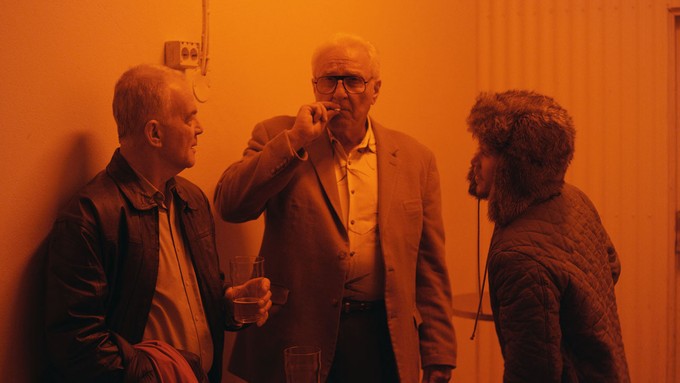
VINYARD: The tone of the movie is borderline…not quite surreal, but borderline over-the-top, but firmly placed in reality at the same time. You said a lot of the tone was crafted when you got there, and shaping the movie on set, but to what extent do you think Colin and Mitch's journey is something…not believable, but it's something to aspire to. When you made this movie, was it sort of, "I wish older guys could do this," or, "Older guys should do this?"
AARON: When we were writing the script, I don't know if we had a theme or point in mind, but as the movie evolved and as we realized more about what this movie is, I think that more than anything, the movie's about living in the moment and aappreciating what you got when you got it. Whether you're 25 or 55 or 75, you should look around you and see who's there.
MARTHA: Get off your damn phones and experience the moment! (they laugh)
AARON: That's what I'm saying. But I think that's what the movie's about. It's about being honest with each other, and finding a way to connect and finding a way to escape your regular like and really look at what's around you. Yeah, I think older guys should do it, but so should I! So should everyone! Everyone should realize what's around them, whether they're in Iceland or in the suburbs. There's real stuff around us.
MARTHA: Things to discover about yourself and the world around you.
VINYARD: "Smoke the joint," is the message of the movie. No matter what age you are, when someone passes you the joint, smoke the joint.
MARTHA: Obviously. I always partake.
AARON: At the same time, we've gotten different interpretations from people of what the point or theme of the movie is. For me, I feel that's what I get out of it, or one of the things I get out of it, but I really like that there are different interpretations. By making the guys- yes, the world has a familiar genre structure, but the guys are real, they're complex, and there are different meanings you can take from it. It's not just one message, and to me that's really important. I don't think I'd want to make a movie that has a clear message.
VINYARD: You could've easily made a scene about Colin confronting Mitch and saying, you know, "Get a grip on yourself! You manipulated me to come here and take life more seriously," blah, blah, blah, but there's never that scene because this is…a good movie. It's not force-feeding itself, like you said, pushing the point.
AARON: Other people have commented that they thought Mitch was going to reveal that he has cancer or he's dying or something. We never even considered going in a direction like that. It's not to say big things don't happen in life. People have cancer, people die in car crashes and get divorced or whatever. But most of life is the small things, and those are the things we're dealing with every day. That's what we wanted these guys to be dealing with, because the small things are what we're dealing with, so they're big things to us.
LAND HO! is currently only playing in NYC and L.A., but it's continually expanding from now through September. Check out where it's playing, as well as any other info about the film, at the official website.
-Vincent Zahedi
”Papa Vinyard”
vincentzahedi@gmail.com
Follow Me On Twitter
